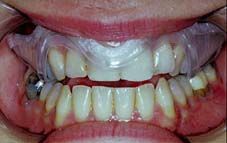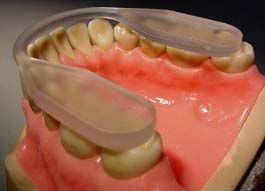|
|||||||||
|
|
|||||||||
| Bites
Piero Silvestrini, M.D., Ph.D., D.S. |
||
|
Bite is a word meaning generically anything we put between our teeth.
There are scores of different types of these appliances, i.e. from
prefabricated to customer-designed models. Each one has its own
peculiarity and indications. Other almost synonymous terms with
"bite" are: splint, orthotic, plate, bite plane, michigan, hawley,
jig, mouth guard, etc. Basically, however, apart from a few really
complex and unlucky situations, two different and specific types
of appliances are used, which are appropriate for different treatments
and pathologic situations. There are prefabricated appliances to
be used only if molars are present, allowing for a quick objective
diagnosis but lasting only a few weeks, whereas other customer-designed
appliances are aimed at a long-lasting therapy. However, we can
argue that bites, as the word says, are used to MODIFY the bite
between the upper and lower dental arch, to restore a lost occlusal
position or to create a new chance of healing or for neuromuscular
and articular reconstitution. Furthermore, they are also used to
restore lost postural patterns and, therefore, anything related
to them, namely: headache, back pain, cervical pain, torticollis
(wryneck), formication in the limbs, plantal cushions, muscular
efficiency in sportsmen, vertigo, ear hum, sleep apnea, etc. Practically
speaking, they may have a contact surface with the teeth of the
opposite plane arch or reproduce tooth shapes DIFFERENT from those
present in the mouth.
|
||
 |
Any
type of "sheath" molded on the teeth, even if in elastic material,
only repeating their shape, IS NO THERAPEUTIC APPLIANCE, but absolutely
a NONSENSE with no therapeutic rationale.
|
|
|
Sheath
molded on the teeth, repeating their shape is no therapeutic bite
|
||
| Scores of prefabricated bites have been proposed. Our experience allowed us to identify two models specific for an early treatment of mastication pathologies. . | ||
 |
One
is a soft model, based on the hydraulic principle of communicating
vasa, producing re-adjustment and a very quick relaxation of the
masticatory muscles. Particularly suitable for merely muscle-contraction
pathologies.
|
|
|
Soft,
hydrodynamic, prefabricated bite means muscular problems
|
||
 |
The
other is a rigid model, very peculiar because it is not tooth borne,
but is freely moving between the teeth. Very appropriate for early
diagnosis and correction of vicious habits and parafunctions such
as, for example, teeth clenching, lip biting, bruxism, etc. Sometimes,
this type of bite has proven to be appropriate to soothe pain and
algic episodes caused by trigeminal neuralgia.
|
|
|
Bite
preconfezionato duro: parafunzioni
|
||
|
Obviously, because of their non-customer-designed typology, these appliances are not very comfortable and easily worn, though offering an immediate pain relief in case of moderately severe temporomandibular joint disorders. Bites providing a new occlusal position, that is to say allowing to verify in the course of time a maxillo-mandibular realignment as to dental shape and function are known as orthotic appliances. They have a dual value: firstly, they ensure a new balanced occlusion while helping swallowing; second, they allow to verify the selected position for any future substitutive therapies. Their phonetic and visual impact is really negligible and, except for rare therapeutic indications, it is generally worn on the lower arch for a better comfort. |
||
 |
||
|
Orthotic
appliance: bite with dental modelling locking the bite rim in a
new therapeutical position
|
||
 |
Bites
provided with an almost plane masticatory surface and allowing for
an occlusal disengagement between upper and lower teeth are commonly
called bite-planes.
|
|
| Bite-plane: note the plane mastication surface | ||
|
They
are specific for teeth clenching and bruxism; however, they cannot
provide significant information on patient's future occlusal rehabilitation.
They are generally larger-sized and specifically designed to be worn only by night. Because of their shape, they cause a higher mastication plane, while offering a free movement of the jaw without any noxious occlusal interferenc. |
||
 |
||
|
Bite-plane:
the mastication plane is higher, specifically designed for patients
clenching or grinding at night.
|
||
|
||||||||
